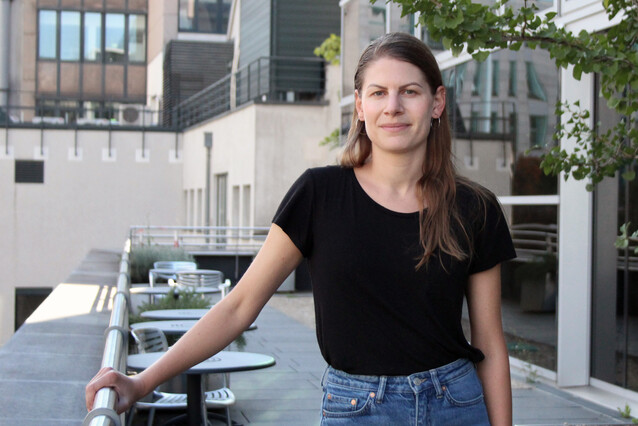IMP student identifies new drivers of plasmablast development
How do the cells that defend us against pathogens develop? Theresa Pinter, PhD student in the lab of Meinrad Busslinger, investigates the molecules that dictate the development of plasmablasts, our first line of defence against infections. In a study now published in the journal Frontiers in Immunology, Theresa and colleagues screened 3,000 genes and identified novel factors that affect the development of plasmablasts.
What is a plasmablast, and what does it do?
When B cells mature throughout their lifespan, they can be ‘activated’ by an encounter with a pathogen. This prompts them to continue maturing into plasmablasts or plasma cells, which are two types of antibody-secreting cells. Plasmablasts arise early in infection as a first line of defence: they participate in the immediate response to help the immune system. The antibodies they produce are less specific to the pathogen because they had to be produced quickly. For B cells to differentiate into plasma cells, however, it takes longer. These cells produce antibodies that are more specific to the pathogen, because they go through several rounds of selection to match the intruder. They’re also the ones that remain in the bone marrow for a very long time, ready to jump into action in case the same pathogen infects the body again.
What do we know about plasmablast development?
When a B cell encounters an antigen coming from a pathogen, it becomes activated – meaning that gene transcription changes. Some genes have to be turned on, some others have to be turned off, so that the cell can change its size and function. These changes are orchestrated by transcription factors – proteins that bind DNA to modulate gene transcription. So far, immunologists had identified some of these factors, but not all.
Do these transcription factors work independently?
No, they form a huge network of molecules that work together. The question is always: have we missed some big players in this network? To answer this question, we designed a comprehensive screen to see if we could identify new molecular factors that affect plasmablast development.
What kind of screen did you use?
We used a type of CRISPR-Cas9 screen in vitro. We started with a library of small guide RNAs that can target certain genes to be cut out by Cas9, an enzyme that acts as ‘DNA scissors’. The library we used was tailored to 3,000 genes we wanted to target. We ran two screens with different selection criteria: in the first one, our target genes were those that are expressed in plasmablasts and upregulated as the plasmablast develops; in the second one, we looked more broadly at all genes expressed in plasmablasts, so that we wouldn’t miss anything.
We then infected B cells with our guide RNAs, activated them to develop into plasmablasts, and waited to observe which ones failed to do so. We deduced that cells that didn’t develop into plasmablasts were missing an important factor, cut out by Cas9.
Which factors did you identify?
Our first screen identified factors that we already knew were important, such as Blimp1 and Irf4, which gives us confidence that our approach is working and relevant. To our surprise, we didn’t find novel factors despite targeting genes that are upregulated in plasmablasts. The second screen, however, highlighted a list of new factors that were not known to contribute to plasmablast development. For example, we identified NIPBL and Mau2, two proteins that are expressed in most cells throughout the body and work together to help folding DNA into the cell nucleus. Removing the genes that encode these proteins doesn’t kill the cells, but it seems plasmablasts need them to develop properly. The next step will be to figure out why.
What other next steps do you foresee in this project?
Miriam Wöhner, a postdoc in our lab, started this project and I took it on. For the rest of my PhD project, I am trying to check how the factors that we identified affect plasmablast development in the context of an entire organism. For instance, I have been working with mice in which I can delete the NIPBL gene specifically in B cells, leaving it intact in the rest of the animal. Ideally, we want to repeat that for other factors and see the effects on plasmablast development in vivo. Stay tuned for our results!
Original publication
